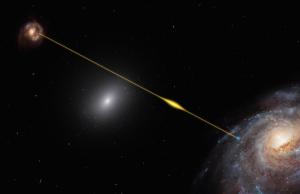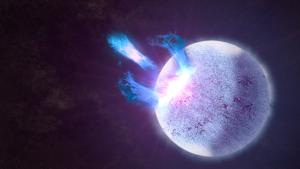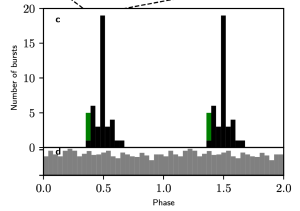Blog
Surprising Regularity
23 June 2020
 ESO/M. Kornmesser
ESO/M. KornmesserFive hundred million light-years from Earth, there is a deeply unusual object. It is radio silent for 12 days, then erupts in bright radio bursts. These fast radio bursts occur randomly over four days, then the object goes silent for another 12 days. Astronomers have observed this object for 500 days, and the pattern always repeats, like clockwork. We still aren’t sure what the object is.
Fast Radio Bursts (FRBs) are notoriously difficult to study. These bright flashes of radio light can outshine a galaxy, but they only last milliseconds. If your radio telescope doesn’t happen to be facing in their direction, you’ll never see one. But recently, wide-field radio telescopes such as CHIME have been able to capture FRBs more easily. What we’re finding is that their behavior is quite strange.
 NASA’s Goddard Space Flight Center/S. Wiessinger
NASA’s Goddard Space Flight Center/S. WiessingerGiven their intensity and short duration, their likely source is a high-density object such as a neutron star or black hole. Many of the models for FRBs involve catastrophic events, such as the last burst of light from a neutron star as it collapses into a black hole or the collision of a neutron star with a white dwarf. But recent studies have shown that some FRBs repeat, and this means that they must be caused by something non-catastrophic.
Earlier this year, CHIME discovered a rather close FRB. While most occur outside our galaxy, this particular burst occurred within the Milky Way. The burst occurred in the direction of a highly magnetic neutron star (or magnetar) known as SGR 1935+2154. It would seem to support the idea that FRBs are caused by the strong magnetic flares of neutron stars. This would explain the repeatability of these bursts. Just as our Sun can undergo periods of activity and quiet, so could neutron stars.
 Amiri, M., et al
Amiri, M., et alBut this latest study complicates things a bit.1 While flares can repeat, they don’t tend to occur with such high regularity. The pattern is so regular that it suggests something more complex is going on. One idea is that while they are caused by magnetar flares, the radio signal is highly directional. A wobble or precession of the magnetar shifts the burst in and out of alignment with Earth over a 16-day cycle. Another idea is that the bursts are instead triggered by some kind of companion with an orbital period of 16 days.
While several FRBs are known to repeat, not all do, and only this latest one is highly regular. This would suggest that there are several processes involved. That means we will need many more observations to understand these mysterious objects.
Amiri, M., et al. “Periodic activity from a fast radio burst source.” Nature 582.7812 (2020): 351-355. ↩︎